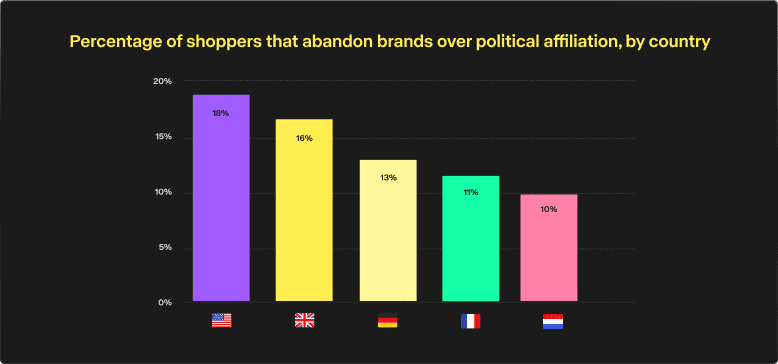Every international retailer knows there are multiple differences — some minor, some dramatic — in consumer preferences between different countries.
To successfully sell across borders, enterprise retailers require a country-by-country approach, carefully aligning product assortments, marketing communications and payment methods with local preferences.
A recent SCAYLE survey of consumers in five key markets — the U.S., the UK, Germany, France and the Netherlands — reveals the key differences between shoppers’ mindset. This article will explore the similarities and differences among these consumer groups, providing retailers and brands with a “do’s and don’ts” guide to selling across borders.
UK Consumers’ Distrust of AI Runs High
Artificial intelligence (AI) is already reshaping multiple aspects of the shopper journey, promising highly personalized product recommendations in the discovery and research phases to handling actual transactions via agentic AI bots. In fact, AI has become so pervasive so quickly that a majority (69%) of consumers across all five markets remain mistrustful of its uses in retail.
While this wariness is likely to recede as more consumers use AI-powered solutions, the message to retailers is clear: proceed cautiously with any customer-facing AI deployments, reassuring and educating consumers about the technology’s benefits and the safeguards your organization has built into its AI offerings.
Concerns about AI run highest in the UK; respondents there were 10% to 15% less comfortable with AI uses in retail than shoppers in other countries, while French consumers showed the least hesitation about using AI during their shopper journeys. For example, 44% of UK consumers expressed concern about AI-created product images and models, compared to 26% of French consumers (and 30% of U.S. shoppers).
Nearly as many UK shoppers, 41%, are worried about AI-powered customer service chatbots, compared to 30% in the U.S. and 24% in France.
U.S. Consumers Most Likely to Abandon Brands over Political Affiliations

With a few exceptions, enterprise retailers have shied away from making overt political statements. That’s understandable given their desire to avoid alienating shoppers — even a relatively small group — who might disagree with their stance.
However, it seems brands can’t totally avoid these kinds of repercussions, particularly in the U.S. Nearly one in five American consumers (18%) will abandon a brand over political affiliation — the highest among the five markets that SCAYLE studied — followed closely by the UK at 16%. As with AI, French consumers are the least concerned about the intersection of politics and retail: only 10% abandon brands when they disagree with their politics.
Consumers also are sensitive to the ethical values brands espouse as well as how they actually operate — particularly when it comes to employees’ working conditions. The survey revealed that, on average, 14% of consumers cited these conditions as reasons they abandon a brand, led (again) by the UK, at 17%, followed by the U.S. and France (both at 14%).
The leading reason why consumers abandon a brand, however, remains product quality, cited by 35% of respondents across the five countries, followed by long delivery times (26%), poor online shopping experiences (23%) and the inability to use a preferred payment method (21%).
Subscriptions Remain a Hard Sell Outside the U.S.
Subscription commerce, when done well, can be a true win-win for consumers and retailers. Shoppers get the convenience of removing items from their shopping lists; retailers get recurring revenue and the opportunity to collect additional customer data through regular contact with subscribers.

Unfortunately, there’s significant consumer resistance to subscriptions: nearly half (48%) of shoppers in all the markets studies say they’re unlikely to subscribe for products, even those they buy frequently. Dutch consumers are the least enamored of subscriptions: only one in three are likely to sign up, the lowest of any of the surveyed markets.
In fact, it’s U.S. consumers that are setting the trend in accepting subscription commerce. A majority (56%) of U.S. shoppers describe themselves as likely to sign up for subscriptions, compared to 33% saying they are unlikely to do so (the remainder fall into the “don’t know/no answer” category). Those marketing subscriptions in Europe may need to wait for these countries’ consumers to catch on to these programs’ benefits; in the meantime, they should study the most successful programs in the U.S. to import their best features. Discover more about the similarities and differences among consumers in these five important markets by accessing the SCAYLE report, Inside the Shopper Mindset: How Global Brands Can Meet Local Expectations.












